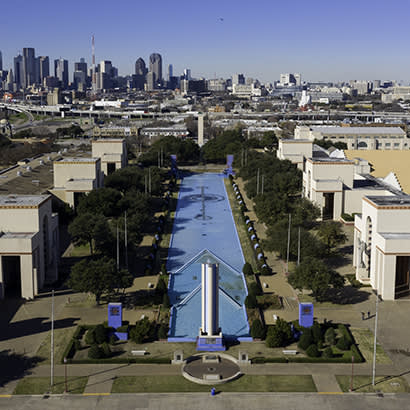
For an enhanced digital experience, read this story in the ezine.
For 135 years, Fair Park in Dallas — the site of The Cotton Bowl and the State Fair of Texas — has been a local treasure. But throughout the decades, revitalization has been increasingly needed.
Over time, the park has experienced a long list of setbacks: financial shortfalls, tensions with its neighboring communities, management turnover, loss of tenants, and a lack of ongoing preservation and maintenance. These setbacks led to a loss of identity, relevancy and use for the park. The site had become a sleeping giant that would awaken once a year for the state fair or an occasional event, but then would quickly return to a state of dormancy and neglect.
Putting the Park Back in Fair Park
In 2014, Dallas Mayor Mike Rawlings convened a task force to discuss the future of Fair Park. Its recommendations included the need to enhance access and activity, “to put the park back in Fair Park,” and to establish a public-private partnership to manage and market the park.
In January 2019, these recommendations took form when the new operators of Fair Park — Fair Park First, Spectra and Biederman Redevelopment Ventures (BRV) — were chosen to revitalize the park.
Addressing Fair Park’s Challenges
The biggest struggle for Fair Park is becoming a space for recreation and leisure on an everyday basis, year-round. This is where the new operators of Fair Park stepped in to provide a slate of free programming and amenities with the goal of building an everyday audience. BRV’s philosophy is simple — program first, then everything else will follow.
BRV also has led the development of an updated master plan in partnership with the Minneapolis office of the design firm Perkins and Will. The principal goal of this plan is to green the park. Currently, the grounds are comprised of more than 75 percent impervious surfaces with parking lots accounting for most. This has led to the park’s alternative moniker — Fair Parking. This overarching issue lays the foundation of the plan’s recommendations — to turn gray into green, increase the site’s resiliency and create more usability.
The Community Park within Fair Park is the first step to putting the green back in the park and the first project from the master plan to be implemented. Currently, the location of what will become the Community Park is one of the site’s largest parking lots, but was historically a Black neighborhood acquired via eminent domain in the 1960s to provide the State Fair of Texas with more parking.
One of BRV’s goals for the new Fair Park is to give back to the surrounding community and to restitch the neighborhood by building a state-of-the-art space that is curated by the community — from design to programming to amenities. The Community Park will be the epicenter for daily programming and will feature Texas-sized amenities — splash pads, multiple play structures for different ages and abilities, a performance pavilion, and flex lawns, to name a few. Studio-MLA of Los Angeles has been selected as the park designers and the park is slated to be completed by 2024.
By turning gray to green and providing free programming — selected by those who live near the park — the new Community Park will be a welcome addition to Fair Park.
Dan Biederman is President of Biederman Redevelopment Ventures Corporation.

